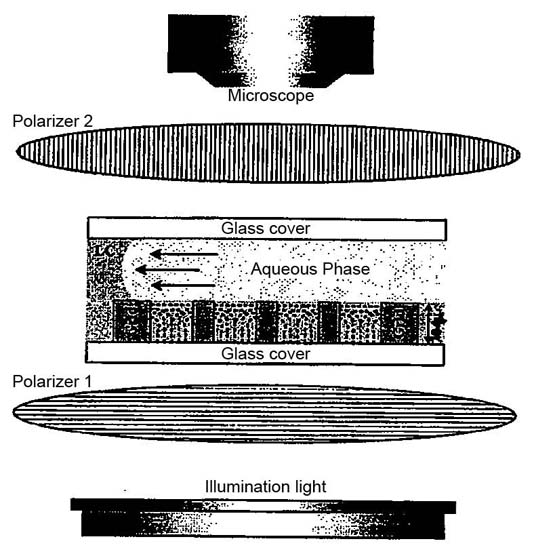Analytical Instrumentation, Methods & Materials

Robust Biological and Chemical Detection Method and Microfluidic Device with Liquid Crystal Sensing Element
WARF: P09136US
Inventors: Hongrui Jiang, Daming Cheng
The Wisconsin Alumni Research Foundation (WARF) is seeking commercial partners interested in developing an improved biological and chemical detection device and method integrating liquid crystals.
Overview
Detecting chemical and biological agents at low levels is important in military applications, drug enforcement, airport security and environmental monitoring. A variety of devices and methods currently are employed for this purpose. For example, gas chromatography has been implemented widely into airport security since 2001 for chemical detection of explosives, and nucleic acid detection methods have been employed by U.N. officials to identify biological weapons. However, most current detector technologies require advanced technical training and are impracticable for use in the field due to large size or fragility.
UW-Madison researchers previously developed a simple, robust device and method for detecting biological agents in water or similar aqueous substances (see WARF reference number P06457US). The device employs a thin polymeric membrane that dissolves in the presence of a target compound at a speed correlated to the concentration of the target.
Liquid crystals also have been used for the detection of biological or chemical agents. Liquid crystals exhibit unique anisotropic physical properties that make them particularly well suited for detecting trace amounts of compounds.
UW-Madison researchers previously developed a simple, robust device and method for detecting biological agents in water or similar aqueous substances (see WARF reference number P06457US). The device employs a thin polymeric membrane that dissolves in the presence of a target compound at a speed correlated to the concentration of the target.
Liquid crystals also have been used for the detection of biological or chemical agents. Liquid crystals exhibit unique anisotropic physical properties that make them particularly well suited for detecting trace amounts of compounds.
The Invention
UW-Madison researchers have now developed an improved method for autonomously generating stabilized liquid crystal thin films and two microfluidic devices that employ the technique for detecting trace amounts of biological agents and chemical compounds. The handheld microfluidic devices each contain a microchannel defined by grooved polymer materials sandwiched between glass substrates. Priming the device involves filling the microchannel with liquid crystal material, which fills specific nickel-plated structures in the channel, and flushing the liquid crystals outside the container with the laminar flow of an aqueous solution. This method allows for automatic formation and rapid regeneration of the stable aqueous/liquid crystal interface.
In the presence of a target compound the orientation of the liquid crystals changes, altering optical properties of the liquid crystals through a phenomenon known as optical birefringence. After the analyte has been introduced into the channel, a white light is passed through a first polarizing lens, the microfluidic device, and a second orthogonally oriented polarized lens. The intensity of the light, determined by the degree of optical birefringence, is detected by a microscope to confirm the presence or absence of the specific target in the aqueous solution.
The microfluidic biological and chemical detection device with a liquid crystal sensing element allows for automatic formation of the sensing interface through its design and operation. The device design also provides better control of the interaction between the aqueous target containing solution and liquid crystal region. By providing a robust device and method, as well as reducing the need for advanced technical training, the improved detection apparatus will greatly enhance in-field applicability of biological and chemical sensor technologies.
In the presence of a target compound the orientation of the liquid crystals changes, altering optical properties of the liquid crystals through a phenomenon known as optical birefringence. After the analyte has been introduced into the channel, a white light is passed through a first polarizing lens, the microfluidic device, and a second orthogonally oriented polarized lens. The intensity of the light, determined by the degree of optical birefringence, is detected by a microscope to confirm the presence or absence of the specific target in the aqueous solution.
The microfluidic biological and chemical detection device with a liquid crystal sensing element allows for automatic formation of the sensing interface through its design and operation. The device design also provides better control of the interaction between the aqueous target containing solution and liquid crystal region. By providing a robust device and method, as well as reducing the need for advanced technical training, the improved detection apparatus will greatly enhance in-field applicability of biological and chemical sensor technologies.
Applications
- Biological and chemical sensing at very low concentrations
- Early detection of biological and chemical agents in military applications
- Industrial chemical hazard warning systems
- Drug enforcement
- Airport and border security
- Environmental pollution monitoring
Key Benefits
- Enables automatic operation of integrated liquid crystal sensing devices
- Eliminates need for careful manual handling and technical training
- Provides real-time, repeatable sensing tasks in the field
- Utilizes liquid crystal sensing within the microfluidic device
- Allows automatic formation of sensing interfaces
- Provides control over the target phase/liquid crystal interaction
Stage of Development
Prototype of both devices were able to detect adsorption of the cationic surfactant dodecyltrimethylammonium bromide (DTAB) as well as biomolecular interactions between a phospholipid and the enzyme phospholipase A2 (PLA2).
Additional Information
For More Information About the Inventors
Related Technologies
Tech Fields
For current licensing status, please contact Jennifer Gottwald at [javascript protected email address] or 608-960-9854
Figures
